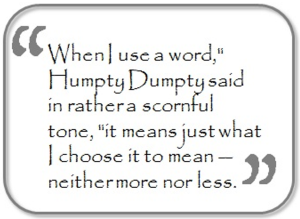Flashback to freshman year, Furman University, Philosophy 101. The course was team-taught by a pair of young professors who billed themselves as “The Edwards and McDonald Vaudeville Team.” (And God bless you both, wherever you are today!)
Among the many insanely indispensable insights I carried away from that course was their relentless reminder to “define your terms.” We can’t have a meaningful dialogue unless we share a common understanding of the concepts we are discussing, using language we can agree on.
that course was their relentless reminder to “define your terms.” We can’t have a meaningful dialogue unless we share a common understanding of the concepts we are discussing, using language we can agree on.
As explained in my inaugural post, my sole goal is to bring together recent research from the fields of neuroscience, psychology, psychometrics, and predictive analytics and use that research to create a coherent approach to increasing performance and well-being in one’s career and life—what I refer to as achieving exponential performance. Drawing on my training from Edwards and McDonald, then, the first step is to introduce and explain the two core models. First up: the Performance Equation.
Model #1: The Performance Equation
Before trying to understand exponential performance, it makes sense to start with a clear explanation of performance, period. Be it superior or poor, high or low, performance comprises three factors. Indeed, Dr. John C. Marshall, psychologist and founder of Self Management Group, describes performance as an actual 3-factor multiplication equation. It’s multiplication because if any of the three is missing—that is, equal to zero—then the result is also zero. Conversely, when all are present at high levels, the overall result grows larger.
The first element of performance in this equation is T for talent. Talent can be thought of as a combination of who you are (i.e., your inherent traits and hard-wired personality) and what you know (i.e., your skills, knowledge, and abilities). Talent reflects what you can do.
The next factor is E for effort. Like talent, effort has two components. Effort is a combination of what you think (your attitudes and beliefs) and what you actually do (your actions). Effort reflects what you will do.
Clearly, the can do versus the will do is important. I have tons of can do when it comes to healthy eating. I understand how calories work.  I have the intellectual capacity to master the Dietary Guidelines for Americans. I have the cooking skills and the manual dexterity to rip the skin off my chicken before I broil it. I am conscious of the fact that kale chips are more nutritious than cronuts. And yet…when I want a snack, what I all too often will do is reach for some lovely, yummy carbs.
I have the intellectual capacity to master the Dietary Guidelines for Americans. I have the cooking skills and the manual dexterity to rip the skin off my chicken before I broil it. I am conscious of the fact that kale chips are more nutritious than cronuts. And yet…when I want a snack, what I all too often will do is reach for some lovely, yummy carbs.
The third and final factor in Dr. Marshall’s Performance Equation is O for opportunity. Opportunity refers to the success potential available to you in any given professional environment. Every company pursues its own mission, and operates with its own structure and culture. Every job has a specific content focus, with specialized skill and knowledge requirements.
In this model of performance, Dr. Marshall asserts that the more closely your talent and effort levels match the known success attributes of a given opportunity, the more likely you are to thrive and flourish there. That is to say, the better your fit with the opportunity, the higher performance level you are predicted to achieve. As it happens, he’s got 35 years of psychometric research data to support that. But I’m getting ahead of myself. More about that later.
At this point, we’ve covered one goal, one model, and three factors. In the next post, we’ll begin delving more deeply into the Performance Equation and develop a definition of what it means to achieve exponential performance.
~ ~ ~


